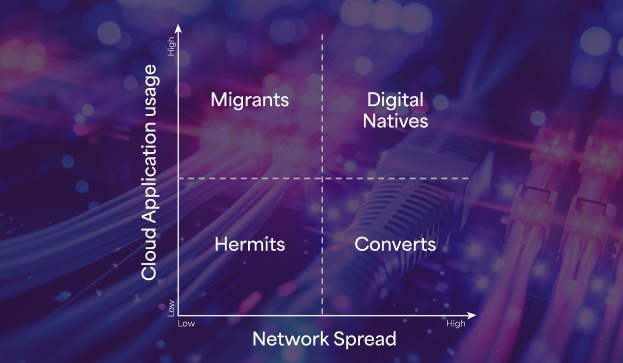Enterprise networks are essential for businesses of all sizes. They provide the foundation for communication, collaboration, and productivity. Given the increasing digitization and migration to SaaS, traditional MPLS based links may not be optimal from functionality, cost and reach standpoint. “Security” as the mainstay of MPLS is increasing losing significance in light of emerging edge security components making Internet leased lines and broadband economical alternative for enterprise networks. They offer a pervasive network coverage and rapid on-demand bandwidths which helps evolve an agile Enterprise network at scale.
However, there are some concerns about the reliability of broadband for enterprise networks.
One of the biggest concerns about broadband is that it can be unreliable. There is a general perception of being a “Public Networks there is limited control on network performance parameters like packet loss and latency, coupled with no Service level agreements. This is because broadband is a shared medium, which means that it can be affected by other users on the network. If there are a lot of users on the network, it can slow down due to network congestion. There is no inherent method for traffic routing or prioritization in broadband networks thus all customer traffic is often left to the mercy of “standard path based on traffic conditions”. These concerns often make Enterprise customers wonder if Broadband is Secure for their traffic, Stable to support their network requirements and Scalable enough to roll out across their network. Thus, Enterprises often wonder if they are losing their network integrity as a trade-off for lower costs of broadband networks. There are serval key changes in technology evolution which have however changed the landscape of Internet Leased Lines and Broadband over the past few years.
Peering and Internet exchanges
Gone are the days of a tall Peering hierarchy when you would hop multiple AS numbers to reach Clouds on broadband networks. Peering is much more prevalent even with smaller ISPs. Coupled with increased presence of Internet exchanges which offer rapid interconnect paths for routing broadband networks today have extremely low latency and minimal hops to reach common destinations like hyperscale clouds or private data centers.


Drop in bandwidth pricing & redundancy
Driven by abundance of supply and migration of most networks to GPON, backhaul bandwidth has become a commodity. Peering and internet exchanges mentioned above result in low load on “true internet connectivity” as most consumer Video traffic gets routed through peering connections leaving the traffic highway empty for enterprises. Most ISPs also have a redundant connection from at least 2 providers based on price/ peering results. The end result is much higher throughputs & least latency paths for enterprise applications – e.g. a promised 50 mbps is likely to provide consistent 20-25 mbps even at sub 75 ms latency even at peak congestions vs 5—10 mbps at 130 ms + latency, half decade back.
Cloud based firewall & SDWAN
The biggest transformation has been ushered in by the era of SaaS connectivity to clouds and evolution of Software Defined WAN. The migration to Software as a Service (SaaS) has resulted in changing of traffic profile for enterprise networks with higher % of traffic moving to internet breakouts. Cloud based firewalls and SDWAN’s together offer better end-point security at application and user level which far surpass the traditional 128 bit MPLS encryption with Class of Service protocols. E.g. with SDWAN it is possible to create intent aware, application aware and latency aware networks providing increased application performance with granular control over security.

So should your Enterprise evaluate migration to Broadband / ILL based networks. We would suggest mapping your current network on below two axis to identify your quadrant and plan accordingly. There are two key parameters to evaluate this migration.
Cloud application usage – This can be restricted to Office365 or expand all the way to usage of SaaS applications like SAP or cloud hosting of applications/ databases.
Each of these quadrants represent a different “Network Payback score” which is defined as Network Payback score (NPS) =
Reduction in Total Cost of ownership over 5 years / Cost of migration Total cost of ownership (TCO) – Should account for cost of on-site engineers, site visits for configuration changes and cost of multiple tools being used to manage evolving business needs. Cost of migration includes (COM) – Time of personnel in planning and effecting the migration, the professional services and One time charges involved in migration of networks, cost of knowledge upgrade and training for IT personnel on new technologies. This will categorise your network as shown in the chart below

If you are a:
- Hermit – at the bottom left quadrant, you can continue with existing MPLS links and site-based firewalls. Network Payback score (NPS) is likely to very low primarily driven by high COM not justified by TCO reductions given limited network size. Hermits should deploy a wait and watch mindset to migration and evaluate migration plans based on moving laterally or upwards.
- Migrants – is perhaps the logical evolution of Hermits. There may have been an ingress of SaaS applications or migration to cloud which has increased requirements of “internet breakout”. Traditional networks would need central aggregation for internet breakout adding latency for access to clouds. Migrants would benefit from migration to Cloud based firewalls to begin with. The higher up they are on the Y-axis the better their NPS score would be for migration to SDWAN together with Cloud based UTM’s.
- Converts – Converts is a stage of evolution for HERMITS who were on the borderline on network reach. This could be a Bank or Retail stores planning expansion leading to complexity of rapid expansion. Converts would have a high NPS score from migration to SDWAN’s together with their migration to Enterprise Broadband as underlay networks. They may not yet require full fledge migration to Cloud based firewalls as security features inherent in many SDWAN solutions should satisfy their needs.
- Digital Natives – These are at the apex of their digital journey. Companies who have evolved from being Converts or Migrants substantially moving to SaaS and reach. Digital natives are likely to have the highest NPS score driven by ability to fully leverage the cost efficiencies of Enterprise broadband, enhanced security features of a Cloud based UTM and high flexibility of SDWAN solutions.
There would be some exceptions to frameworks where hybrid networks may solve problems for Hermits or Converts. Ultimately a diagnostic study of current network and more importantly expected Business evolution would help align a solution. A 360 degree approach to network planning would ensure that migration to broadband in underlay is driven by objective analysis rather than hype cycles.






